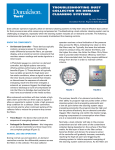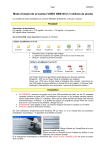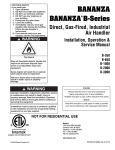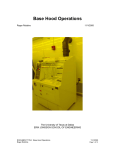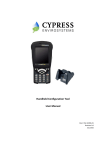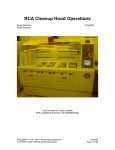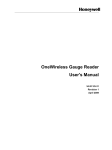Download DCT500A - Dwyer Instruments, Inc.
Transcript
BULLETIN E-98A Series DCT500A Timer Controller Specifications – Installation & Operating Instructions 75 25 300 200 150 R31 1 HIGH LIMIT 250 125 50 175 1 2 3 4 5 6 7 8 9 10 400 R29 100 SEC 200 CONNECT JUMPER TO LAST CHANNEL USED TIME ON 350 150 50 DWYER INSTRUMENTS MICHIGAN CITY, IN 100 TIME OFF 450 500 mSEC COM LOW LIMIT POWER ON 05-443179-00 VER 0 FVN 1.0.0 INDUSTRIAL CONTROL EQUIPMENT LINE INPUT RATING 120 VAC +10%-15% 50/60 HZ SINGLE PHASE. THIS UNIT MUST BE ENCLOSED. USE NEC CLASS 1 WIRING RATED 60C/75C. USE 14-22 GA COPPER ONLY FOR LINE AND LOAD CONNECTIONS. TORQUE TERMINALS TO 5 IN. LB. REPLACE FUSE WITH TYPE 3AG FAST ACTING 3 AMP 250V ONLY. FAILURE TO COMPLY WITH THESE REQUIREMENTS WILL VOID MANUFACTURES WARRANTEE. D16 4-1/4 [107.95] 4-7/8 [123.8] WIRE STRIP GAUGE 0.250 IN. MAX DO NOT USE SLOW BLOW FUSES LINE VOLTAGE 102 VAC TO 132 VAC MAX 50-60 HZ L1 L2 SOL 1 COM 2 3 4 5 6 7 8 9 10 OUTPUTS (300 VA MAX) 6-1/4 [158.75] 1/16 [1.59] 6-3/4 [171.45] 1-21/64 [33.73] Introduction The Series DCT500A Timer Controller is a timing system for pulse-jet type dust collectors or pneumatic conveying systems in either continuous or on-demand cleaning applications. It is provided with either 4, 6, or 10 channels. The DCT500 was designed for ease of installation in your dust collector system. For installations requiring fewer channels than available on the board, a shorting plug is provided to allow selection of the last used channel. Time-on and time-off settings are selected using two potentiometers. High-limit and low-limit control inputs are provided for use with on-demand systems. When used in a continuous mode the high-limit input is jumped. For safety, the control circuitry including the control inputs and the last channel jumper, is isolated from the power line. Installation Warning: Always install and service this device with the power off and a lockout installed if required. Line voltages are exposed on the board. As a result, this device is not intended to be installed in any open location. It must be installed within an enclosure that meets appropriate safety and local code requirements. Follow applicable safety procedures when installing or servicing this product. Warning: Always replace the fuse with the proper type and rating. The fuse is Type 3 AG fast acting 3 Amp @ 250V. DO NOT use slowblow type fuses. Failure to comply with this requirement will pose a serious safety risk and will void manufacturer’s warranty. Warning: As a permanently installed piece of equipment, a power disconnect switch, circuit, or other approved disconnect device must be installed in close proximity to the installed board and within easy reach of the operator. This disconnect device must include a label indicating its function as a mains disconnect. Power Requirements The controller is designed for operation on 120 VAC 50/60 Hz power. The input voltage must be between 102 VAC and 132 VAC either 50 or 60 Hz. The solenoid loads must be rated for 120 VAC operation. Location The system must be located in an enclosure that meets relevant safety standards and electrical codes. There are no other special orientation requirements. Mount it using the four mounting holes in the baseplate. The baseplate back is flush, so no special spacers are needed to accommodate obstructions except for those imposed by the location itself. Installed screws and other mounting hardware must maintain a spacing of 0.250 in (6.35 mm) from the circuit board. DWYER INSTRUMENTS, INC. P.O. BOX 373 • MICHIGAN CITY, INDIANA 46361, U.S.A. 1/2 [12.70] SPECIFICATIONS Output Channels: 4, 6, & 10 channels. Voltage Requirements: 102 to 132 VAC (~) 50 or 60 Hz. Power Consumption: 1.8 W. Input Power: 302 VA max. Load: 300 VA max, pilot rating C300. Fuse: Type 3 AG, 3A @ 250 VAC (~). Ambient Operation Temperature: -40 to 149°F (-40 to 65°C). Storage Temperature: -40 to 176°F (-40 to 80°C). Humidity Conditions: 5 to 95% noncondensing. On Time: 50 to 500 msec. On Time Accuracy: ±5% of setting. On Time Repeatability: ±1 msec. Off Time: 1 to 180 seconds. Off Time Accuracy: 5% of setting. Pollution Degree: 2. Altitude: 6560 ft (2000 m) max. Environment: Indoor use, must be installed in a weather-proof enclosure for outside applications. Weight: 9 oz (255 g). Agency Approvals: UL, cUL, CE. Connections The line and solenoid connections are located at the lower edge of the board. The terminal block is a “Euro” style connector system that clamps the wire within the connector body. The connector will accept wire sizes from 14 to 22 gages. Wire must be copper only with at least 60°C or 60/75°C rated insulation. These terminals should be torqued to 5 in. lb. The connectors are specified for single connection but multiple wires may be connected to a single lug provided local codes allow this and good workmanship practices are followed. When using stranded wire, make sure that there are no “stray” strands. These pose safety hazards and may cause system failure or damage. Connect the line power to L1 and L2. Connect the solenoids between the selected output and the solenoid common. Solenoid common and L2 are internally connected. Refer to Figure 2-1. The wire should be stripped to no more than 0.25 in. A strip gauge is provided at the lower right corner of the board. Longer than this may cause shorts or expose line voltages to possible contact. Switches connected to the control inputs at the top of the board must be isolated normally open contacts connected only to the relevant terminal and to the common terminals. The following subparagraphs describe the external switch connections. Refer to figure 2-1 for switch connection illustration. Phone: 219/879-8000 Fax: 219/872-9057 www.dwyer-inst.com e-mail: [email protected] SHORT FOR CONTINUOUS OPERATION HIGH LIMIT PRESSURE LIMIT SWITCHES LOW LIMIT TIME OFF Time Off and Time On Setup Time off defines the period of time between solenoid activations when no channels are enabled. This value may be set between 1 second and 200 seconds with a resolution of 1 second. Time on defines the solenoid on time. The value may be set between 50 msec and 500 msec with a resolution of 10 msec. If adjustments are made while the system is in operation, the new setting will take effect in the following solenoid cycle. Do not use excessive force to turn the potentiometers. This will damage the unit. A factory installed option is available for a time on range of 0.05 to 10 seconds. CONNECT JUMPER TO LAST CHANNEL USED 1 2 3 4 5 6 7 8 9 10 TIME ON TB2 HIGH LIMIT COM LOW LIMIT 0.31 TYP [7.87] 4 PLACES TB1 L1 L2 SOL 1 2 COM 3 4 5 6 7 8 9 10 OUTPUTS (300VA MAX) 8.88 [225.6] 7.73 [196.3] LINE INPUTS SOLENOIDS FIGURE 2-1 Switch Connections External Limit Switch Connection The controller may be used with an external pressure limit switch or sensor to provide demand-cleaning operation. A three pin terminal block provides connection for external high and low limit switches. A simple on-off system can be established with a single pressure switch connected to the high limit input. Better control can be achieved with a high and low limit switch/gage such as the Dwyer Photohelic® pressure gage. The switches must be isolated contacts between the high or low limit input and the common connection. The wiring from the switches must be two or three wires with no other connections made to these. The common line must not be connected to equipment ground or protective ground, since these may introduce electrical noise and cause improper operation or possible damage to the control board. The operation of these inputs is summarized as follows: 4.00 [101.6] 4.00 TYP [101.6] 4.45 [113.0] 5.74 [145.8] Weatherproof Enclosure Option Low Limit Current Switch Operation Open Hold X Hold or Run Ø Hold Closed Hold Closed Run Closed Hold ≠ Run Ø – Transition from open to closed ≠ – Transition closed to open X – Either open or closed High Limit Switch Open Closed Open Ø ≠ Ø Open Next Operation Hold Run Hold Run Run Run Hold Explanation of Symbols: Symbol Caution: Risk of electric shock Caution: Risk of danger, refer to user’s manual for further information Operating Modes Continuous Cycle Mode The DCT500A has two operating modes available for different applications. Starting with the most basic mode, it is capable of operating in a continuous cleaning cycle. This can be initiated by placing a jumper between the high limit input and the common connection. Two setup parameters control operation: time off, time on. Time on and time off specifically deal with the solenoid on time and the time interval between the end of the on pulse and the start of the next. Demand Mode Demand mode operation can be configured using the high limit and low limit inputs. A simple on-off system can be setup with a single pressure switch connected to the high limit input. Better control can be achieved with a high and low limit switch set such as is provided in the Photohelic® pressure gage. In this on-demand mode, time on and time off may be programmed to define the cleaning cycle. When the cleaning cycle is completed, the controller will continue the cycle until the last channel is pulsed. The next cleaning cycle will always start on channel 1. A factory installed option is available that will not clean to the end of the cycle, but rather stop where the cleaning cycle ended. The next demand for cleaning will start the subsequent channel where the last cleaning cycle left off. ~ Alternating current Agency Approvals and Test Standards: UL: UL508: 2008 IEC 61010-1: 2001-02 CE: System Setup Last Channel Selection A jumper connector is provided to select the last channel used. Place the jumper on the two pins corresponding to the last channel used in the installation. ©Copyright 2009 Dwyer Instruments, Inc Description IEC 61000-4-2: 2001 IEC 61000-4-3: 2006 IEC 61000-4-4: 2004 IEC 61000-4-5: 2005 IEC 61000-4-6: 2006 IEC 61000-4-11: 2004 CENELEC EN 55022: 2007 FCC Part 15 CFR Title 47: 2007 ICES-003: 2004 Digital Apparatus (Industry Canada) ANSI 63.4-2003 CENELEC EN 61326-1: 2006 2004/108/EC EMC Directive Printed in U.S.A. 7/09 DWYER INSTRUMENTS, INC. P.O. BOX 373 • MICHIGAN CITY, INDIANA 46361, U.S.A. Phone: 219/879-8000 Fax: 219/872-9057 FR# 05-443180-20 Rev.2 www.dwyer-inst.com e-mail: [email protected]



